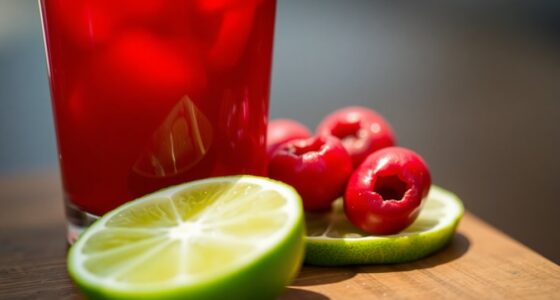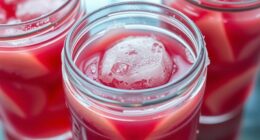Fresh juice is best enjoyed within 24 to 72 hours. For peak flavor, aim to drink it within the first 24 hours. If you use a centrifugal juicer, expect the juice to last around 24 hours because of oxidation. Masticating juicers can keep juice fresh for up to 48 hours, while cold-pressed juice can last 3 to 5 days. Want to know how to store your juice for the best results? There's more to explore!
Key Takeaways
- Fresh juice typically lasts between 24 to 72 hours in the refrigerator, with the best taste within the first 24 hours.
- Centrifugal juicer juice remains fresh for about 24 hours due to higher oxidation rates.
- Masticating juicer juice can last up to 48 hours, as it reduces oxidation compared to centrifugal juicers.
- Cold-pressed juice from a twin gear juicer can stay fresh for 4 to 5 days.
- Adding lemon juice can extend freshness by slowing down oxidation and preserving vitamin levels.

When you whip up a batch of fresh juice, you might wonder how long it’ll stay good. Fresh juice typically lasts between 24 to 72 hours in the refrigerator when stored properly, with the best taste experienced within the first 24 hours. The freshness you enjoy right after juicing is unmatched, but it’s essential to know how to store fresh juice effectively to maximize its shelf life. To extend the fresh celery juice shelf life, it’s important to use airtight containers and keep your juice away from direct light and heat. Additionally, consuming the juice as soon as possible will not only ensure optimal flavor but also preserve the maximum nutrient content. If you’re unable to drink the juice within a day, consider freezing it in ice cube trays for later use, which can help maintain its quality for longer periods.
One important factor is the type of juicer you use. If you're using a centrifugal juicer, your juice will likely last around 24 hours. This is due to the high-speed operation, which introduces more air into the juice, accelerating the oxidation process. If you prefer masticating juicers, you'll find that your juice can last up to 48 hours. These juicers extract juice at a slower speed, reducing oxidation and preserving more nutrients.
The best option for longevity is a twin gear juicer, which can keep your cold-pressed juice fresh for 4 to 5 days. So, if you want to make your juice last, investing in a quality juicer might be a wise choice.
Storing your fresh juice in airtight containers is crucial for maintaining its quality. Glass containers work best, as they don't leach chemicals like some plastics can. Keeping your juice at temperatures between 35-40°F (1.6-4.4°C) helps slow down nutrient degradation and prevents bacterial growth.
If you leave your juice exposed to air, you'll notice that it starts to lose its vibrant color and flavor, signaling that it's time to consume it or risk it going bad.
Adding natural preservatives like lemon juice can also help extend the freshness of your juice. The acidity in lemon juice slows down the oxidation process and helps maintain vitamin levels. Just a splash can make a difference, allowing you to enjoy your juice for a bit longer while still reaping the health benefits.
It's worth noting that while cold-pressed juice can maintain its freshness for 3 to 5 days, pasteurized juice may last even longer, but you'll sacrifice some nutrients in the process. So if you prioritize health benefits, sticking with fresh juice is always a great choice.
Frequently Asked Questions
How Long Can You Keep Juice After Juicing?
After juicing, you can keep your juice for varying lengths of time, depending on how it's made.
If you use a cold-pressed juicer, it'll stay fresh for about 3-5 days in the fridge.
Centrifugal juicers only last around 24 hours.
To maximize freshness, store your juice in airtight glass containers and keep it at a temperature between 35-40°F.
Adding lemon juice can also help maintain quality for longer.
How Long Is Fresh Cold-Pressed Juice Good For?
Fresh cold-pressed juice usually lasts about 3-5 days in your fridge if you store it properly.
Sometimes, it can stay fresh for up to 7 days, depending on the ingredients you use. High-acid fruits like citrus can help extend its shelf life.
To maximize freshness, keep the juice at a cold storage temperature of 35-40°F.
Can You Drink 4 Day Old Juice?
You're staring at that 4-day-old juice, wondering if it's still safe to drink. The suspense builds as you recall its vibrant color and fresh aroma from days ago.
But wait—has it changed? Before taking a sip, check for any off smells or a sour taste.
If it seems off, don't risk it. Trust your instincts; your health's more important than a few sips of questionable juice. Better safe than sorry!
Do You Have to Drink Juice Immediately After Juicing?
You don't have to drink juice immediately after juicing, but it's best to consume it right away for maximum nutrition.
Fresh juice can lose nutrients quickly due to oxidation. If you store it properly in an airtight container, you can extend its freshness for a few days.
However, for optimal taste and health benefits, aim to enjoy your juice within the first 72 hours after juicing. Your body will thank you!
Conclusion
In summary, fresh juice is best consumed right away, but if stored properly in the fridge, it can last for up to 72 hours. Remember, "a stitch in time saves nine"—taking the time to store your juice in an airtight container can help maintain its flavor and nutrients. So, enjoy your juice fresh, but don't fret if you need to save some for later; just handle it with care!
Cindy thoroughly researches juicing trends, techniques, and recipes to provide readers with practical advice and inspiration. Her writing style is accessible, engaging, and designed to make complex concepts easy to understand. Cindy’s dedication to promoting the advantages of juicing shines through her work, empowering readers to make positive changes in their lives through the simple act of juicing.

















